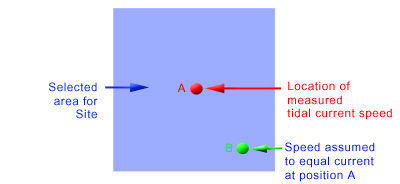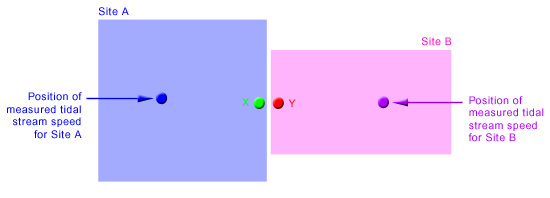


| Selected Areas and Depth |
Technology Constraints Assumption 1 Assumption 2
Technology constraints
The 1st Generation of MCTs – which are scheduled to be commercially available by 2008 – will be installed and operated in depths of between 20 to 50 metres For depths of greater than 50 metres 2nd Generation technology will have to be developed to exploit marine current energy at this depth.
Therefore, two areas around each site were selected that were considered to be suitable for MCTs:
- Firstly, an area with depths of 20-50 metres for 1st Generation MCTs,
- Secondly, an area with depths between 50 and 80 metres for the 2nd Generation technology.
back to top
Assumption 1
The method employed when assessing the resource is not accurate enough to provide velocities for very small areas (e.g. less than 1km2) because Tidal Stream Atlases only provide measurements at a large scale and are therefore not very specific.
Also, the tidal stream arrows marked on Admiralty Charts (which have much smaller scales and thus give more detail) used during the Tidal Data Validation stage, only identify certain high-speeds tidal streams and give speeds for the entire areas of the sites that were of interested.
Therefore, when selecting the area for a site, the speed for all tidal currents within the area were assumed to equal the tidal-speed measurements for the point of latitude and longitude taken from the Tidal Stream Table, as shown in the figure below:

This assumption may cause problems if the selected area is quite large (e.g. greater than 5 km2) as the speed may in reality vary above and below this speed because of topographical differences on the seabed. However it was decided that the tidal speeds above and below the assumed speed would cancel each other out.
This problem highlighted the fact, that a much more detailed tidal stream measurement tool is required to obtained the level of detailed required to complete an accurate study of the resource in Scotland. Recent Studies by Marine Current Turbines ltd for an assessment of the Northern Irish tidal resource, used the ADCP (Acoustic Doppler Current Profiler) an advanced device mounted under a ship or moored, that provides detailed data on the speed and direction of ocean currents. Such technology is very expensive and would require massive resources to accurately measure the tidal streams around Scotland. It was decide for the purposes of this study our method was the only method available.
back to top
Assumption 2
It was also assumed that the times at which the tidal speeds occur were assumed to equal the times allocated to single tidal-speed measurements for the point of latitude and longitude when the Tidal Data for all the sites was linked during the resource assessment.
This may cause problems later when combining the potential power output of multiple MCT sites if we select several large sites (> 5 km2) around adjacent positions of tidal-current speed. For example, the time and speed could differ between the two adjacent sites by 1 hour. This will introduce errors because 2 points (points X and Y in the figure below) immediate adjacent to each other but which lie in different designated site areas are assumed to differ in time and speed by 1 hour, when in actual fact, they may only vary by a few minutes.

For this reason, when selecting the sites to combine together into a supply strategy, it was decided to select areas that were not positioned adjacent to each other. (This restricted the size of baseload we might supply.)
back to top